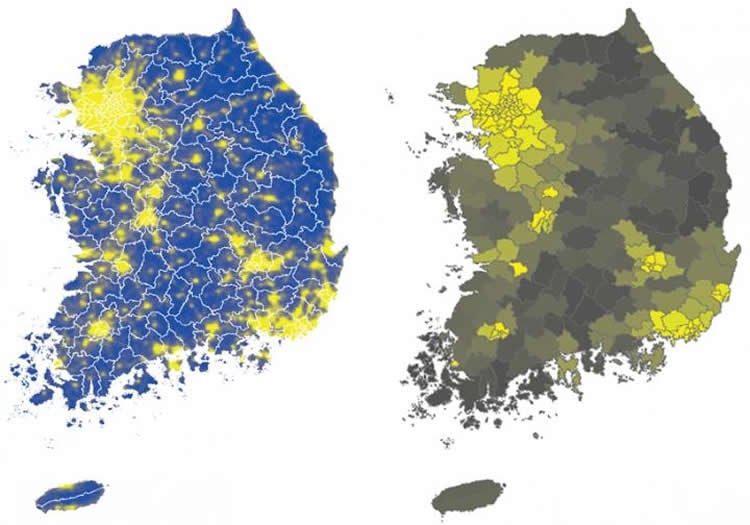Summary: Researchers report increased light pollution resulting from outdoor artificial light exposure is linked to a higher risk of sleep disorders and prescription of hypnotic drugs in older people.
Source: AASM.
A new study is the first population-based investigation to report a significant association between artificial, outdoor light exposure at night and insomnia, as indicated by older adults’ use of hypnotic drugs.
Results show that increasing nighttime levels of artificial, outdoor light exposure, stratified by quartile, were associated with an increased prevalence of hypnotic prescriptions and daily dose intake. Furthermore, older adults exposed to higher levels of artificial, outdoor light at night were more likely to use hypnotic drugs for longer periods or higher daily dosages.
“This study observed a significant association between the intensity of outdoor, artificial, nighttime lighting and the prevalence of insomnia as indicated by hypnotic agent prescriptions for older adults in South Korea,” said Kyoung-bok Min, PhD, an associate professor in the Department of Occupational and Environmental Medicine at Seoul National University College of Medicine in South Korea. “Our results are supportive data that outdoor, artificial, nighttime light could be linked to sleep deprivation among those while inside the house.”
The study results are published in the Nov. 15 issue of the Journal of Clinical Sleep Medicine.
According to the American Academy of Sleep Medicine, insomnia can involve struggling to fall asleep, having trouble maintaining sleep, or waking up too early. A variety of environmental factors, including excessive noise or light and extreme temperatures, will disrupt the sleep of most individuals.
The authors reported that the inappropriate or excessive use of artificial, outdoor light at night, referred to as “light pollution,” has emerged as a novel environmental factor linked to human health. Research has shown that artificial nighttime lighting, whether indoor or outdoor, induces disruption of circadian rhythms, potentially leading to metabolic and chronic diseases, including cancer, diabetes, obesity and depression.
The study used data from the 2002-2013 National Health Insurance Service-National Sample Cohort (NHIS-NSC), a population-based cohort in South Korea. The final study sample, after excluding those with a diagnosed sleep disorder, comprised 52,027 adults who were 60 years of age or older. About 60 percent of participants were female.

Light exposure was based on satellite data provided by the National Centers for Environmental Information. The estimated light pollution level in each administrative district was matched with individuals’ residential districts to determine an individual exposure level.
Usage data for two hypnotic drugs, zolpidem and triazolam, were extracted from health insurance records. About 22 percent of study participants had prescriptions for hypnotic drugs.
Min added that public health officials seem to be less concerned with light pollution than with other environmental pollutants. However, this study strengthens the potential link between light pollution and adverse health consequences.
“Given the recent scientific evidence including our results, bright outdoor lighting may be a novel risk factor for prescribing hypnotic drugs,” Min said.
The authors noted that more studies and public policy initiatives are needed to define and minimize the adverse effects of light pollution on human health.
Funding: The study was supported by the Education and Research Encouragement Fund of Seoul National University Hospital and by National Research Foundation of Korea (NRF) grants funded by the South Korean government (Ministry of Science and ICT).
Source: Corinne Lederhouse – AASM
Publisher: Organized by NeuroscienceNews.com.
Image Source: NeuroscienceNews.com image is credited to Journal of Clinical Sleep Medicine.
Original Research: Open access research for “Outdoor Artificial Nighttime Light and Use of Hypnotic Medications in Older Adults: A Population-Based Cohort Study” by Jin-young Min, PhD; and Kyoung-bok Min, PhD in Journal of Clinical Sleep Medicine. Published November 2018.
doi:10.5664/jcsm.7490
[cbtabs][cbtab title=”MLA”]AASM”Light Pollution May Cause Insomnia in Older Adults.” NeuroscienceNews. NeuroscienceNews, 30 November 2018.
<https://neurosciencenews.com/light-pollution-insomnia-10281/>.[/cbtab][cbtab title=”APA”]AASM(2018, November 30). Light Pollution May Cause Insomnia in Older Adults. NeuroscienceNews. Retrieved November 30, 2018 from https://neurosciencenews.com/light-pollution-insomnia-10281/[/cbtab][cbtab title=”Chicago”]AASM”Light Pollution May Cause Insomnia in Older Adults.” https://neurosciencenews.com/light-pollution-insomnia-10281/ (accessed November 30, 2018).[/cbtab][/cbtabs]
Abstract
Outdoor Artificial Nighttime Light and Use of Hypnotic Medications in Older Adults: A Population-Based Cohort Study
Study Objectives
Outdoor artificial nighttime light is increasingly recognized as a form of environmental pollution. Excessive nighttime light exposure, whether from indoor or outdoor sources, has been associated with a number of deleterious effects on human health. We performed a population-based cohort study in South Korea to assess the possible association between outdoor nocturnal lighting and insomnia in older adults, as measured by prescriptions for hypnotic drugs.
Methods
This study used data from the 2002–2013 National Health Insurance Service-National Sample Cohort (NHIS-NSC), and a total of 52,027 adults who were age 60 years or older were included in the study. Light data were based on satellite mapping of artificial light. The usage data of two hypnotic drugs, zolpidem (N05CF02) and triazolam (N05CD05), were extracted from the NHIS-NSC records.
Results
Of the 52,027 patients in this cohort, 11,738 (22%) had prescriptions for hypnotic drugs. Increasing outdoor artificial nighttime light exposure (stratified by quartile) was associated with an increased prevalence of hypnotic prescriptions and daily dose intake. Compared with individuals in the lowest quartile 1, the regression coefficients for prescription days and daily defined doses of all hypnotic drugs and certain hypotonic drugs were significantly higher among those living in areas with higher outdoor artificial nighttime light (quartiles 2 through 4).
Conclusions
Outdoor artificial nighttime light exposure was significantly associated with prescription of hypnotic drugs in older adults. These findings are consistent with the hypothesis that outdoor artificial nighttime light may cause sleep disturbances.






